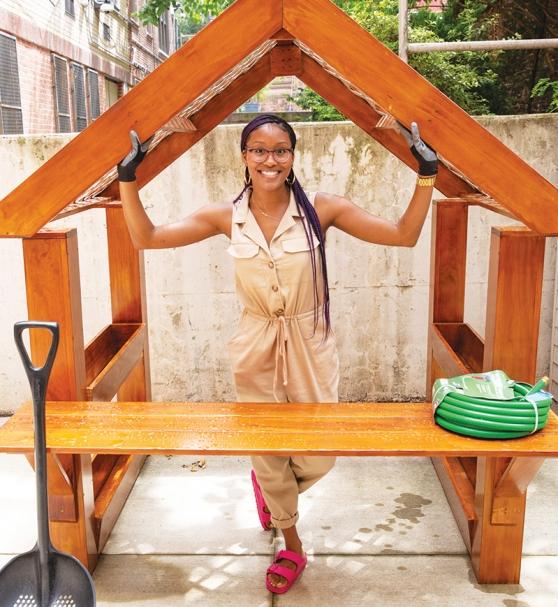Who will teach the kids?

Jazzmen Murphy, who became a teacher through an alternative-certification program, teaches special education at PS 77 in Brooklyn, where her students gained vocational skills over the summer by planting a garden and staining the gazebo.
More than two years after the COVID-19 pandemic barreled down on an already stressed K-12 system, teacher burnout and dissatisfaction have joined low pay and an anemic educator pipeline to make the nation’s teacher shortage more acute.
The longstanding wage gap between teachers and other college grads, the lack of popular support for public education, the increased emphasis on standardized testing, and the way that schools have become a stage for the nation’s cultural and political wars have all contributed to making the profession less attractive.
The number of college graduates with education degrees has declined over the years even as more than 270,000 teachers now leave the profession annually.
Pandemic challenges have added fuel to the fire. Students returned to classrooms with “enormous needs,” placing additional responsibilities and stress on educators, an American Federation of Teachers task force looking into the shortage found. In a recent AFT survey, 74% of teachers were dissatisfied with their job conditions and 38% said they definitely or probably would leave the profession in the next two years.
In a June 2022 U.S. Department of Education survey about increased teaching and staffing concerns related to the pandemic, 88% of public schools said teacher and staff burnout was the top concern, followed by teacher and staff mental health (82%), the inability to fill vacant positions with qualified applicants (62%), teacher and staff physical health (50%) and teachers and staff retiring early (30%).
New York City’s shortage
The shortages vary greatly among states and communities, but many school systems are struggling. New York State has persistent teacher shortages in many areas, according to a 2021 U.S. Department of Education report. In New York City, the teaching shortage is felt most acutely in high-need subject areas — special education, bilingual education, science, technology, engineering and math.
“Despite the pure heroism our teachers and schools have shown during the pandemic, too many communities are not investing in public education,” said UFT President Michael Mulgrew, who co-chaired the AFT task force.
Nationwide subject-area shortages predate COVID-19 but were exacerbated by the pandemic in many districts, U.S. Education Secretary Miguel Cardona said in a recent statement. He recommended implementing grow-your-own and apprenticeship programs, helping teachers pay off student loans, providing mentoring and leadership or advancement opportunities, and increasing access to affordable preparation programs.
In its July report, the AFT task force recommended increasing salaries and benefits, diversifying the educator workforce, reducing class sizes, curbing the “test-and-punish” use of standardized tests and reducing paperwork.
To help fill in the gaps in New York City, the city DOE launched its Teaching Fellows alternative certification program 22 years ago. Fellows take an intensive seven-week summer training program and obtain a provisional license, then teach full time in a high-need public school. They earn a subsidized master’s degree from a local higher education institution that has a partnership with the DOE.
The NYC Teaching Collaborative is another alternative certification program. Launched in 2012, the five-month spring residency training program also leads to a transitional license and a subsidized master’s degree.
Efforts to promote diversity
The city’s alternative certification programs have been a pipeline for diversifying the teaching force, according to the DOE’s Office of Teacher Recruitment and Quality. From 2018-21, two-thirds of the new hires through the Teaching Fellows and Teaching Collaborative were people of color.
Jazzmen Murphy, who grew up in Bushwick, Brooklyn, was between jobs in 2016 when she was accepted as a Teaching Fellow. After the program, she was hired at PS 77 in Park Slope, Brooklyn, where she teaches grades 7-12. The program is “one of the best things to ever happen to me,” said Murphy.
“They’re doing such great things for people who want to change careers, people like me who always wanted to be educators and just didn’t know how to appropriately find a program, or maybe the traditional way didn’t work for them,” she said.
In a national survey released earlier this year, Educators for Excellence found that 86% of all teachers, but only 52% of teachers of color, planned to teach for their entire career.
Murphy did not have many teachers who looked like her. “I am so happy to be carrying that torch for educators that look like me,” she said.
Teacher turnover rates are high, she said, “but staying is really hard. So, I appreciate all of the educators who look like me and who stay and who are that person to look up to for students who look like us.”
To attract more male teachers, the DOE has a recruitment initiative with the city and the City University of New York called NYC Men Teach. Since 2015, it has recruited more than 3,000 men of color to teach in city schools, also contributing to diversity.
About 35% of city public school teachers hired in 2011-12 had quit by their 10th year, according to a UFT analysis of DOE data, but the city has not seen a massive wave of retirements recently.
“We’ve all seen stories about teacher shortages. They’re across the United States, and now in New York City we’re starting to see more of that,” Mulgrew said. We always had issues with special education, foreign languages, math and sciences, but now we see what’s happening in the rest of the country starting to happen here.”